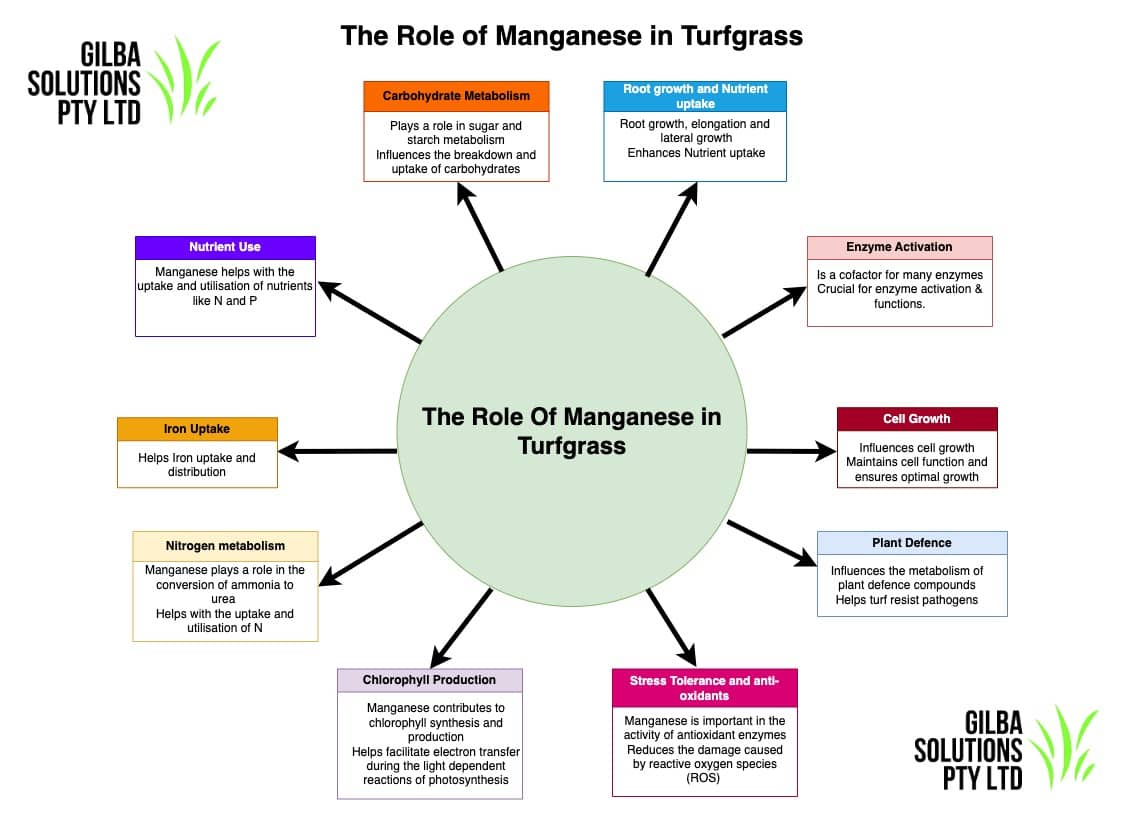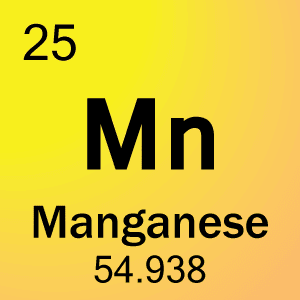Manganese in Turfgrass.
This blog covers the trace element Manganese in turfgrass and Manganese fertilisers. This follows on from our previous blog on Magnesium in turf. We discuss what are acceptable soil Manganese (Mn) levels, and the role Manganese plays in IPM, with an emphasis on the management of ERI.
- Manganese is essential for turf grass growth.
- Mn is not readily redistributed in plants. It pretty much stays put once it deposits where the xylem delivers it from the roots.
- Because Mn is insoluble it is not available to plant roots. For Mn uptake to occur the Mn must be in the divalent Mn++ form.
Role of Manganese in Turfgrass.
- Mn plays a key role in photosynthesis.
- Manganese impacts the growth and colour of turfgrass.
- When Mn is absent, turf loses its colour, and there is a rapid reduction in photosynthesis.
- Turf uses Manganese for several plant enzymes in several metabolic processes.
- Mn plays a role in root elongation and lateral root initiation.
- Mn influences the assimilation and uptake of Nitrogen (N).
- Manganese is important for disease resistance. This is especially the case against take-all.
- Manganese can substitute for Magnesium (Mg) in some reactions in the plant.

When is Mn Deficiency Likely?
- Manganese availability decreases as the soil pH increases.
- Poorly draining soils that have poor aeration tend to have low levels of Manganese.
- Soils that are high in OM or thatch tend to lock up Manganese.
- You may see a reduction in Manganese availability or uptake in soils with high P.
- High levels of Copper, Iron and Zinc may reduce Manganese availability.
Deficiency of Manganese in Turfgrass.
- Deficiencies of Iron (Fe) and Manganese in turfgrass look similar to each other.
- Mn deficiency is seen in young leaves which become discoloured whilst older leaves tend to appear normal.
- You may see interveinal chlorosis on young leaves.
- Leaves can turn yellow or brown, wither and die.
- In severe cases you can see dead spots on leaves.
- The turf cover looks unhealthy and you see a decline in turf health.
- Deficiency of Manganese in turf grass tends to feel soft to the touch.
In reality turf managers are more likely to encounter issues with Manganese deficiency rather than toxicity.
A useful tip if you have low Mn levels, your soil pH is > 7.0 and you have been using urea as your main N source. Simply switch to ammonium sulphate. This reduces the soil pH and so cures Mn deficiency.
What Influences Manganese Availability in Turfgrass?
Soil pH.
Soil pH has a big impact on the solubility of Manganese in turfgrass. This is because the solubility of Mn falls by 100* for every unit increase in the soil pH. The converse occurs as soil pH decreases.
- As the soil pH increases Mn becomes less available. High OM, sandy and overlimed soils are all potentially likely to have this issue.
- Manganese is less available in high pH soils. At a high soil pH Calcium and Magnesium dominate exchange sites leaving no space for Mn.
- Mn is much more soluble and available to plants in acid soils (pH <5.5).
- In low pH soils, Mn can become toxic.
- You are likely too see Mn toxicity where Mn is present in low pH soils, there is a high OM content, soil minerals contain Mn, and the soil is occasionally waterlogged.
Soil Aeration.
In aerated soils, Manganese is less available. In wet soils it is more available.
Organic Matter.
As soil OM increases, exchangeable Mn decreases, and in high OM soils with a soil pH > 6.5 you often see Mn deficiency.
Many turf managers often add organic amendments to their turf. In this situation applications of OM tend to reduce Mn availability as it binds to this additional organic matter.
You often see low levels of soil oxygen in wet soils, and soils with a combination of high soil OM levels plus warm temperatures. These conditions favour microbial activity that reduces the supply of oxygen.
This fall in soil oxygen means that the oxide form of soil Manganese reduces to the soluble Manganese (Mn++) form. This increase in soluble Manganese causes an increase in the amount of plant available Manganese.
The result is that a waterlogged soil is more prone to Mn toxicity.
Iron Levels.
High tissue iron levels tend to limit the uptake of Manganese in turf and cause a deficiency.
Ectotrophic Root-Infecting (ERI) Fungi.
ERI fungi can “fix” Manganese in the soil, and so reduce its plant availability.
Inter-relationships of Manganese in Turfgrass.
- Mn deficiency is worse in high pH soils. This means high rates of lime or dolomite can worsen the problem.
- Low K also interferes with Mn uptake.
- Deficiencies of Mn and Cu often occur at the same time.
- High Mn levels induce Fe deficiency.
Table of Manganese Nutrient Antagonism.
Excess | Effects |
Manganese | Iron, Magnesium |
Magnesium | Calcium, Potassium |
Nitrogen | Potassium, Calcium |
Phosphorus | Zinc, Iron, Copper |
Potassium | Nitrogen, Magnesium, Calcium |
Iron | Manganese |
Sodium | Potassium, Calcium, Magnesium |
Copper | Iron, Manganese, Zinc |
Calcium | Boron, Phosphorus, Magnesium |
Zinc | Iron, Manganese |
Sulphur | Manganese, Iron, Zinc |
Manganese Fertilisers.
Manganese, does not move in the phloem like Magnesium. This means you need to apply it via the soil. In contrast, the more mobile Magnesium can be applied by foliar spray.
Here are some of the more common Manganese fertilisers used in Australian turf.
Manganese Sulphate.
Manganese Sulphate is completely water soluble Manganese fertiliser and is quickly available to the plant after soil application. One of the great properties of this is that you can also use Manganese sulphate as a foliar application.
After an hour 15-20% of the Manganese sulphate tends to become unavailable. This is because when the Mn comes into contact with water it oxidises. The balance then remains plant available for several weeks.
Just like Iron sulphate, if you get this on pathways or cart paths you will get staining.
Manganese Oxysulphate.
Oxysulfates are created when Manganese oxide reacts with sulphuric acid. The extent of this reaction determines the degree of water soluble Manganese.
There is some evidence that to get a quick response from Manganese oxysulphate, it needs to be more than 50% water soluble to be effective.
Manganese Chelate.
Unlike the sulphate form, Manganese chelate tends to remain available under a wide range of soil pH conditions.
The most common synthetic chelate is EDTA. However other synthetic chelates are also available such as EDDHA, DTPA, HEDTA . Organic chelates are usually derived from the paper pulp industry, and include the ligninsulphonates.
The Role of Manganese in IPM.
Manganese has been found to suppress take-all patch on bentgrass. Target levels of Manganese are pH dependent. You can calculate the amount of Manganese available in the soil with the Manganese Availability Index (MnAI).
A point to realise at this stage is that the MnAI is not turf specific but instead is a rough guideline to measure its availability in soils.
The target MnAI ranges from 20 to 150, and depends on the soil type and turf grass.
Manganese Availability Index (MnAI) = 101.7 – 15.2*soil pH + 3.75*Mn mg/kg, For the soil pH use the value in water( 1:1 v/v); for the Mn use Mehlich III extracted Mn values.
For the best turf performance, the ratio of Mn to Fe should be at a ratio of 3:1 Fe: Mn as Mehlich III extracted mg/kg.
ERI and Manganese in Turfgrass.
- Ectotrophic root-infecting (ERI) fungi affect Manganese availability.
- ERI fungi can “fix” soil Manganese.
What is ERI?
ERI fungi are pathogens that live on the outside of plant roots. They cause diseases like Take-All Root Rot and Root Rot of Ultra Dwarf Couch.
Mn “Fixing”.
Some ERI e.g. Gaeumannomyces graminis, reduce the availability of Mn in the soil by locking it up.
Availability of Manganese in Turfgrass and Soil pH:
As we discussed earlier soil pH influences Mn availability. High soil pH reduces Mn availability, and also tends to encourage ERI activity.
Manganese Turf Fertilisers.
Foliar Sprays.
- Foliar applications of Manganese Sulphate are the most effective method in cases of severe deficiency.
- Work has shown that foliar Manganese sulphate every 12-18 months at rates as low as 2.25 Kg Mn/Ha in water volumes of 400 L/Ha, are a good maintenance rate for Manganese.
- When disease pressure is high or soil Manganese in a turf situation is low (<21 milligrams/kilogram Mehlich-3 extractable Mn), a Manganese fertiliser rate of 6.75 kilograms Mn/Ha is needed for more effective control.
- Mn EDTA at 2 Kg/Ha is less likely to burn than Manganese sulphate.
Soil Applications.
- Mn EDTA at 4 Kg/Ha is available up to a soil pH of around 7.5.
Nutrient Balance.
The target is a balanced soil Fe: Mn ratio of 3:1 to optimise turf performance.
Testing Guidelines for Manganese in Turfgrass.
Table 1. Soil Manganese Turf Ranges.
Extractant | Low | Normal | High |
Mehlich III SLAN | < 30 mg/Kg | 30-45 mg/Kg | Unknown |
Manganese Activity Index | < 110 | > 110 | Unknown |
Table 2. Leaf Tissue Manganese Levels in Turfgrass.
Be aware that if you tissue test for Manganese levels can often be misleadingly high. It’s important you are aware of any fungicide applications prior to testing. This is because many fungicides (e.g.Mancozeb) contain Manganese and this can show up in the tissue test results and give an artificially high result.
Turf Type - mature | Low mg/Kg | Normal mg/Kg | High mg/Kg |
Creeping Bentgrass* | < 25 | 25-300 | >300 |
Couch - Tifgreen** | < 20 | 20-300 | >300 |
Perennial ryegrass*** | < 2 | 2-10 | >10 |
* Campbell and Plank 2000 ** Snyder and Cisar, 2000 *** Jones, J. B., Wolf, B., & Mills, H. A. (1991). |

Jerry Spencer
Jerry has an Hons Degree in Soil Science (1988) from Newcastle Upon Tyne University. He then worked as a turf agronomist for the Sports Turf Research Institute (STRI) until 1993.
He gained a Grad Dip in Business Management from UTS in 1999. He has held a number of technical roles for companies such as Arthur Yates (Commercial Technical Manager) and Paton Fertilizers (Organic, turf specialty and controlled release fertiliser) portfolios.
In 2013 he established Gilba Solutions as independent sports turf consultants and turf agronomists. Jerry has written over 100 articles and two books on a wide range of topics such as Turf Pesticides and turfgrass Nutrition which have been published in Australia and overseas.

